If you’re a Fender guitar enthusiast, whether a seasoned collector, a passionate player, or someone looking to buy or sell a Fender instrument, understanding Fender Guitar Serial Numbers is crucial. These numbers are more than just identifiers; they are keys to unlocking the history, age, origin, and potential value of your guitar or bass. This comprehensive guide will walk you through everything you need to know about decoding Fender serial numbers, helping you to confidently navigate the world of Fender instruments.
Decoding Fender Serial Numbers: A Step-by-Step Guide
Determining the age and origin of a Fender guitar using its serial number might seem daunting at first, but by following a structured approach, you can effectively decipher this crucial information. Here’s a step-by-step guide to get you started:
Step 1: Locate the Serial Number
The first step is to find the serial number on your Fender guitar or bass. The location varies depending on the year of manufacture. Common locations include:
- Neck Plate: This is a frequent location, especially for vintage models and reissues. Look at the metal plate that secures the neck to the body of the guitar on the back.
- Bridge Plate: For some of the earliest Fender instruments, particularly from the 1950s, the serial number was stamped on the bridge plate.
- Headstock: From the mid-1970s onwards, Fender predominantly placed serial numbers on the headstock, either on the front or back, depending on the specific era and model.
- Back of the Neck (Near the Neck Joint): For some Fender Japan models, the serial number is located on the back of the neck, close to where it joins the body.
Step 2: Utilize the Fender Serial Number Lookup Guide
Once you’ve located the serial number, the next step is to decode it using a reliable Fender serial number lookup guide. Fender’s serial numbering system has evolved significantly over the decades, and different eras employ distinct formats, often using prefixes, suffixes, and varying digit lengths.
Below is a detailed Fender Serial Number Lookup Guide categorized by location and era to help you pinpoint the production year of your instrument:
The Early Years: Bridge Plate Serial Numbers (1950-1954)
Location: Bridge Plate
Years: 1950-1954 (Early Fender serial number schemes were often model-specific during this period)
Convention: Four or Five-digit Serial Numbers
Models: Telecaster, Broadcaster, Esquire, Precision Bass, Early Stratocasters
Broadcaster, Telecaster, Esquire Guitars:
| Serial Number Range | Year Range |
|---|---|
| 0001 to 0999 | 1950 – 1952 |
| 000 to 5300 | 1952 – 1954 |
Precision Basses:
| Serial Number Range | Year Range |
|---|---|
| 161 to 357 | 1951 |
| 299 to 619 | 1952 |
| 0001 to 0160 | 1952 |
| 0161 to 0470 | 1951 – 1952 |
| 0475 to 0840 | 1952 – 1953 |
| 0848 to 1897 | 1953 – 1954 |
Stratocasters:
| Serial Number Range | Year Range |
|---|---|
| > 6000 | First half of 1954 |
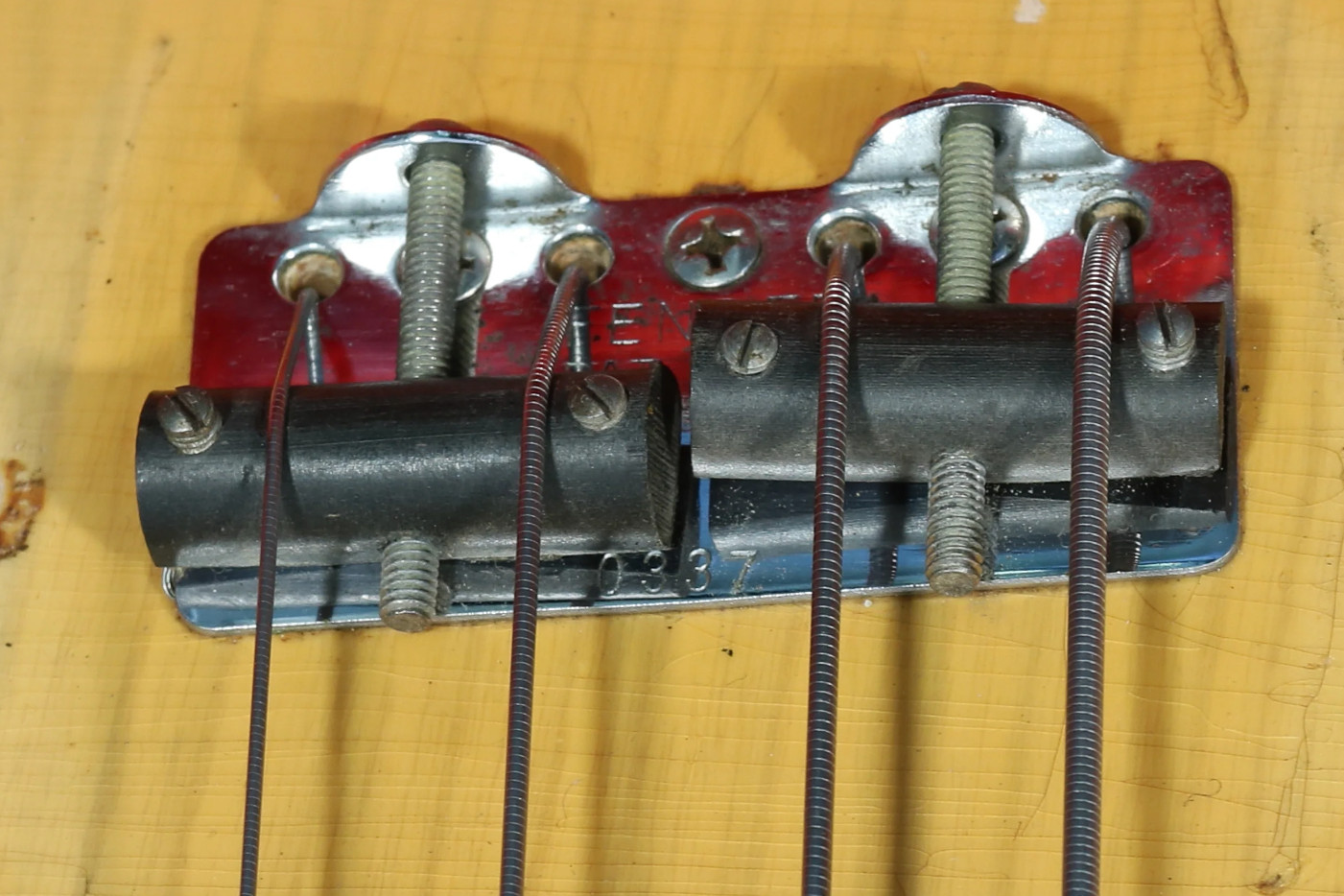 Close-up of a 1952 Precision Bass bridge plate showing the serial number and date.
Close-up of a 1952 Precision Bass bridge plate showing the serial number and date.
Pictured Above: A detailed view of the bridge plate on a 1952 Precision Bass, clearly displaying the serial number and date stamp.
Neck Plate Serial Numbers (1954 – 1963)
Location: Neck Plate
Years: 1954 – 1963
Convention: Four or Five-digit Serial Numbers. (Note: in 1957 and 1958, a “0” or “-” prefix might be present).
Models: Stratocasters, Telecasters, Jazzmasters (introduced in 1958), Jaguars (introduced in 1962), Precision Bass (from 1955), and Jazz Bass (introduced in 1960).
| Serial Number Range | Year Range |
|---|---|
| 0001 to 7000 | 1954 |
| 7000 to 9000 | 1955 |
| 9000 to 17000 | 1956 |
| 17000 to 25000 | 1957 |
| 25000 to 34000 | 1958 |
| 34000 to 44000 | 1959 |
| 44000 to 59000 | 1960 |
| 59000 to 71000 | 1961 |
| 71000 to 93000 | 1962 |
| 93000 to 99999 | 1963 |
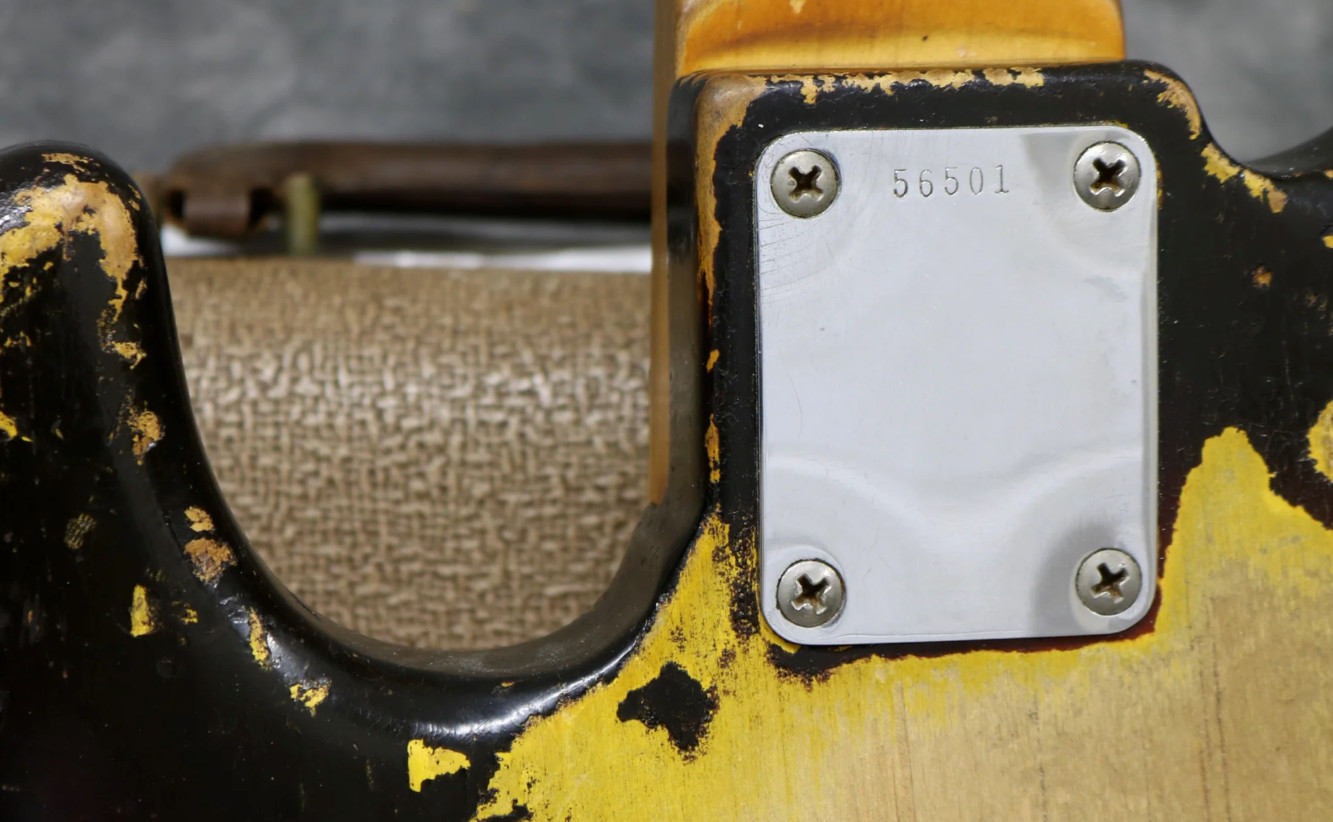 Image showcasing the neck plate of a 1960 Jazz Bass, highlighting the serial number location.
Image showcasing the neck plate of a 1960 Jazz Bass, highlighting the serial number location.
Pictured Above: The neck plate of a 1960 Jazz Bass, clearly showing the serial number stamped into the metal.
L Series Serial Numbers (1963 to 1965)
Location: Neck Plate
Years: 1963 to 1965
Convention: Serial numbers starting with the letter “L.”
| Serial Number Range | Year Range |
|---|---|
| L00001 to L20000 | 1963 |
| L20000 to L59000 | 1964 |
| L59000 to L99999 | 1965 |
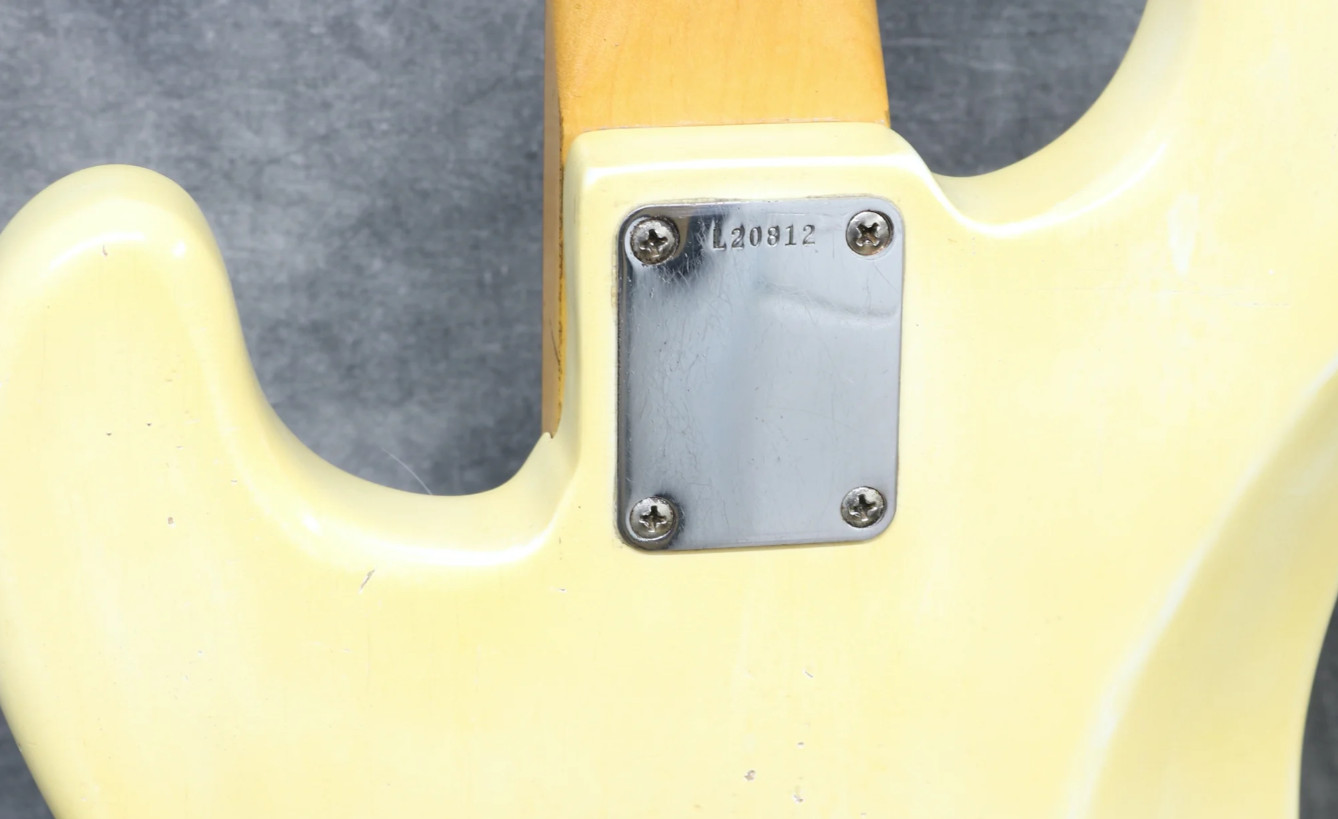 Image of a 1964 Precision Bass neck plate with an L series serial number, emphasizing the 'L' prefix.
Image of a 1964 Precision Bass neck plate with an L series serial number, emphasizing the 'L' prefix.
Pictured Above: A 1964 Precision Bass neck plate, featuring a serial number that begins with the distinctive “L” prefix.
F Series Serial Numbers (1965-1976) – The CBS Era
Location: Neck Plate
Years: 1965-1976 (CBS Era)
Convention: 6 digits with a large “F” underneath the number on the neck plate.
| Serial Number Range | Year Range |
|---|---|
| 100000 to 110000 | Late 1965 |
| 110000 to 200000 | 1966 |
| 200000 to 210000 | 1967 |
| 210000 to 250000 | 1968 |
| 250000 to 280000 | 1969 |
| 280000 to 300000 | 1970 |
| 300000 to 340000 | 1971 |
| 340000 to 370000 | 1972 |
| 370000 to 520000 | 1973 |
| 500000 to 580000 | 1974 |
| 580000 to 690000 | 1975 |
| 690000 to 750000 | 1976 |
 Photo of a 1973 Telecaster neck plate with an F series serial number and the distinctive 'F' logo.
Photo of a 1973 Telecaster neck plate with an F series serial number and the distinctive 'F' logo.
Pictured Above: The neck plate of a 1973 Telecaster, showcasing the “F” series serial number with the characteristic large “F” logo.
Headstock Serial Numbers (Post-1976)
Location: Headstock (Front or back, depending on the model and year)
Years: Post 1976
Convention: Serial numbers starting with a letter indicating the decade, followed by a number for the year within that decade.
Decade Letter Codes:
- S = 1970s
- E = 1980s
- N = 1990s
- Z or DZ = 2000s
| Serial Number Range | Year Range |
|---|---|
| 76 (in bold print) + 5 digits | 1976 |
| S6 + 5 digits | 1976 |
| S7 + 5 digits | 1977 – 1978 |
| S8 + 5 digits | 1978 |
| S9 + 5 digits | 1978 – 1979 |
| E0 + 5 digits | 1979 – 1981 |
| E1 + 5 digits | 1980 – 1982 |
| E2 + 5 digits | 1982 – 1983 |
| E3 + 5 digits | 1982 – 1985 |
| E4 + 5 digits | 1984 – 1988 |
| E8 + 5 digits | 1988 – 1989 |
| E9 + 5 digits | 1989 – 1990 |
| N9 + 5 digits | 1990 |
| N0 + 5 digits | 1990 – 1991 |
| N1 + 5 or 6 digits | 1991 – 1992 |
| N2 + 5 or 6 digits | 1992 – 1993 |
| N3 + 5 or 6 digits | 1993 – 1994 |
| N4 + 5 or 6 digits | 1994 – 1995 |
| N5 + 5 or 6 digits | 1995 – 1996 |
| N6 + 5 or 6 digits | 1996 – 1997 |
| N7 + 5 or 6 digits | 1997 – 1998 |
| N8 + 5 or 6 digits | 1998 – 1999 |
| N9 + 5 or 6 digits | 1999 – 2000 |
| Z0 + 5 or 6 digits | 2000 – 2001 |
| Z2 + 5 or 6 digits | 2001 – 2002 |
| Z3 + 5 or 6 digits | 2003 – 2004 |
| Z4 + 5 or 6 digits | 2004 – 2005 |
| Z5 + 5 or 6 digits | 2005 – 2006 |
| Z6 + 5 or 6 digits | 2006 – 2007 |
| Z7 + 5 or 6 digits | 2007 – 2008 |
| Z8 + 5 or 6 digits | 2008 – 2009 |
| Z9 + 5 or 6 digits | 2009 – 2010 |
| US10 + 6 digits | 2010 |
| US11 + 6 digits | 2011 |
| US12 + 6 digits | 2012 |
| US13 + 6 digits | 2013 |
| US14 + 6 digits | 2014 |
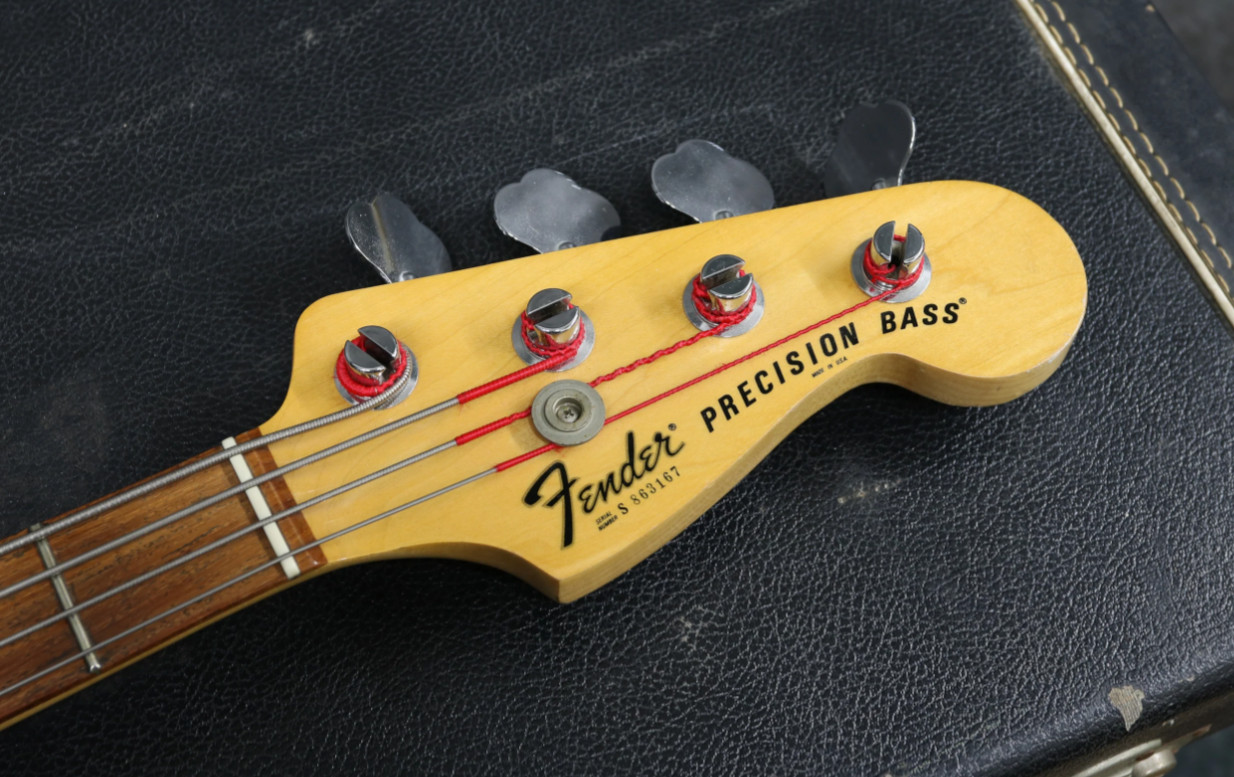 Image displaying the headstock of a 1978 Precision Bass, showing the serial number placement on the headstock.
Image displaying the headstock of a 1978 Precision Bass, showing the serial number placement on the headstock.
Pictured Above: A 1978 Precision Bass headstock, illustrating the typical location of the serial number during this era.
Fender “Made/Crafted in Japan” Serial Numbers (1982 – 2008)
Location: Usually on the back of the neck near the neck joint. Some reissue models may have it on the headstock or neck plate.
Years: 1982 – 2008
Important Note: In 1997, Fender Japan changed the decal from “Made in Japan” (MIJ) to “Crafted in Japan” (CIJ). After 2007, they reverted back to “Made in Japan.”
“Made in Japan” (MIJ) Years – 1982 – 1997:
| Serial Number Range | Year Range |
|---|---|
| JV + 5 digits | 1982 – 1984 |
| SQ + 5 digits | 1983 – 1984 |
| E + 6 digits | 1984 – 1987 |
| A + 6 digits | 1985 – 1986 |
| B + 6 digits | 1985 – 1986 |
| C + 6 digits | 1985 – 1986 |
| F + 6 digits | 1986 – 1987 |
| G + 6 digits | 1987 – 1988 |
| H + 6 digits | 1988 – 1989 |
| I + 6 digits | 1989 – 1990 |
| J + 6 digits | 1989 – 1990 |
| K + 6 digits | 1990 – 1991 |
| J + 6 digits | 1990 – 1991 |
| K + 6 digits | 1990 – 1991 |
| L + 6 digits | 1991 – 1992 |
| M + 6 digits | 1992 – 1993 |
| N + 6 digits | 1993 – 1994 |
| O + 6 digits | 1993 – 1994 |
| P + 6 digits | 1993 – 1994 |
| Q + 6 digits | 1993 – 1994 |
| S + 6 digits | 1994 – 1995 |
| T + 6 digits | 1994 – 1995 |
| U + 6 digits | 1995 – 1996 |
| N + 5 digits | 1995 – 1996 |
| V + 6 digits | 1996 – 1997 |
“Crafted in Japan” (CIJ) Years:
| Serial Number Range | Year Range |
|---|---|
| A + 6 digits | 1997 – 1998 |
| O + 6 digits | 1997 – 2000 |
| P + 6 digits | 1999 – 2002 |
| Q + 6 digits | 2002 – 2004 |
| R + 6 digits | 2004 – 2005 |
| S + 6 digits | 2006 – 2008 |
| T + 6 digits | 2007 – 2008 |
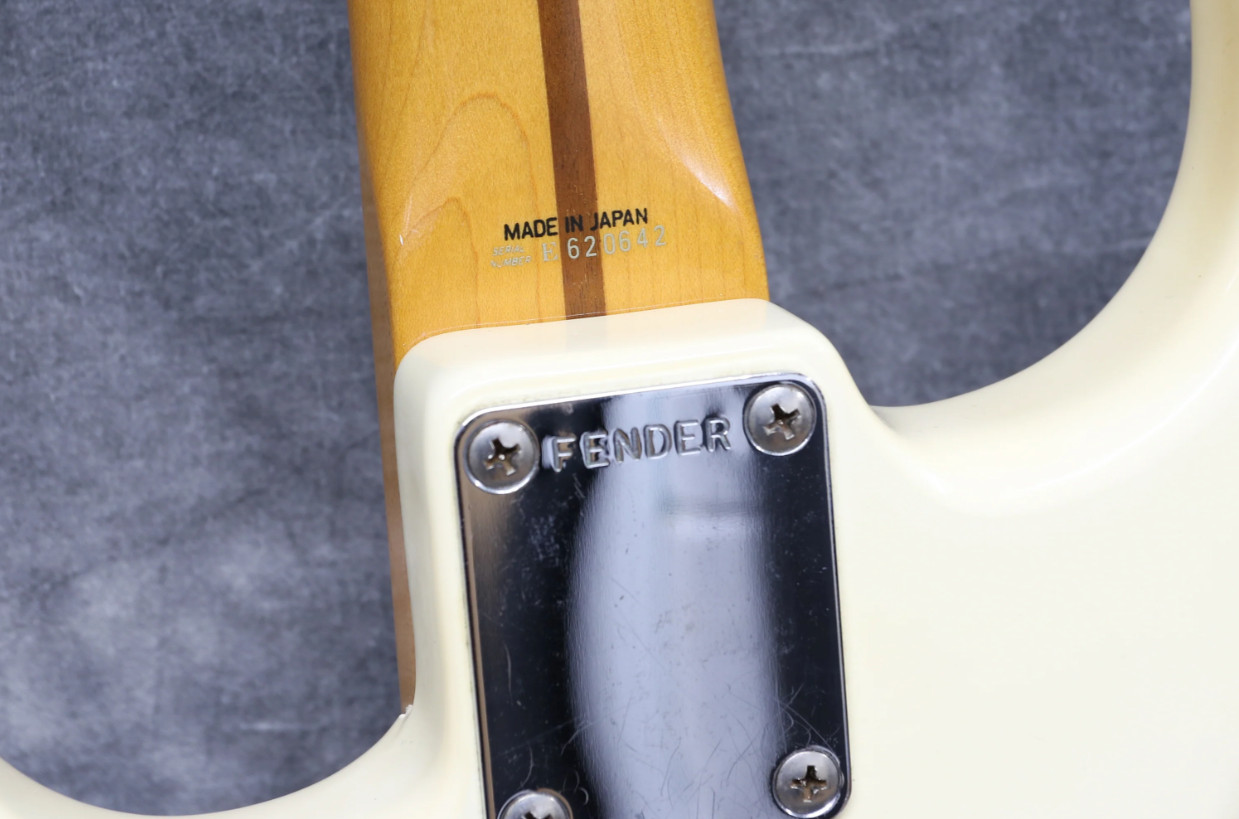 Image of a Fender Stratocaster Made in Japan, showcasing the 'Made in Japan' decal on the headstock.
Image of a Fender Stratocaster Made in Japan, showcasing the 'Made in Japan' decal on the headstock.
Pictured Above: A Fender Stratocaster manufactured in Japan between 1984 and 1987, highlighting the “Made in Japan” designation.
Fender Made in Mexico (MIM) Serial Numbers (1990 – Present)
Years: From 1990 onwards
Unique Characteristics: Mexican-made (MIM) Fenders have a serial number on the headstock starting with “M.” The second letter indicates the decade (N for 90s, Z for 2000s, X for 2010s, etc.).
Location: Headstock
| Serial Number Range | Year Range |
|---|---|
| MN0 + 5 or 6 digits | 1990 |
| MN1 + 5 or 6 digits | 1991 |
| MN2 + 5 or 6 digits | 1992 |
| MN3 + 5 or 6 digits | 1993 |
| MN4 + 5 or 6 digits | 1994 |
| MN5 + 5 or 6 digits | 1995 |
| MN6 + 5 or 6 digits | 1996 |
| MN7 + 5 or 6 digits | 1997 |
| MN8 + 5 or 6 digits | 1998 |
| MN9 + 5 or 6 digits | 1999 |
| MZ0 + 5 or 6 digits | 2000 |
| MZ1 + 5 or 6 digits | 2001 |
| MZ2 + 5 or 6 digits | 2002 |
| MZ3 + 5 or 6 digits | 2003 |
| MZ4 + 5 or 6 digits | 2004 |
| MZ5 + 5 or 6 digits | 2005 |
| MZ6 + 5 or 6 digits | 2006 |
| MZ7 + 5 or 6 digits | 2007 |
| MZ8 + 5 or 6 digits | 2008 |
| MZ9 + 5 or 6 digits | 2009 |
| MX10 + 6 digits | 2010 |
| MX11 + 6 digits | 2011 |
| MX12 + 6 digits | 2012 |
| MX13 + 6 digits | 2013 |
| MX14 + 6 digits | 2014 |
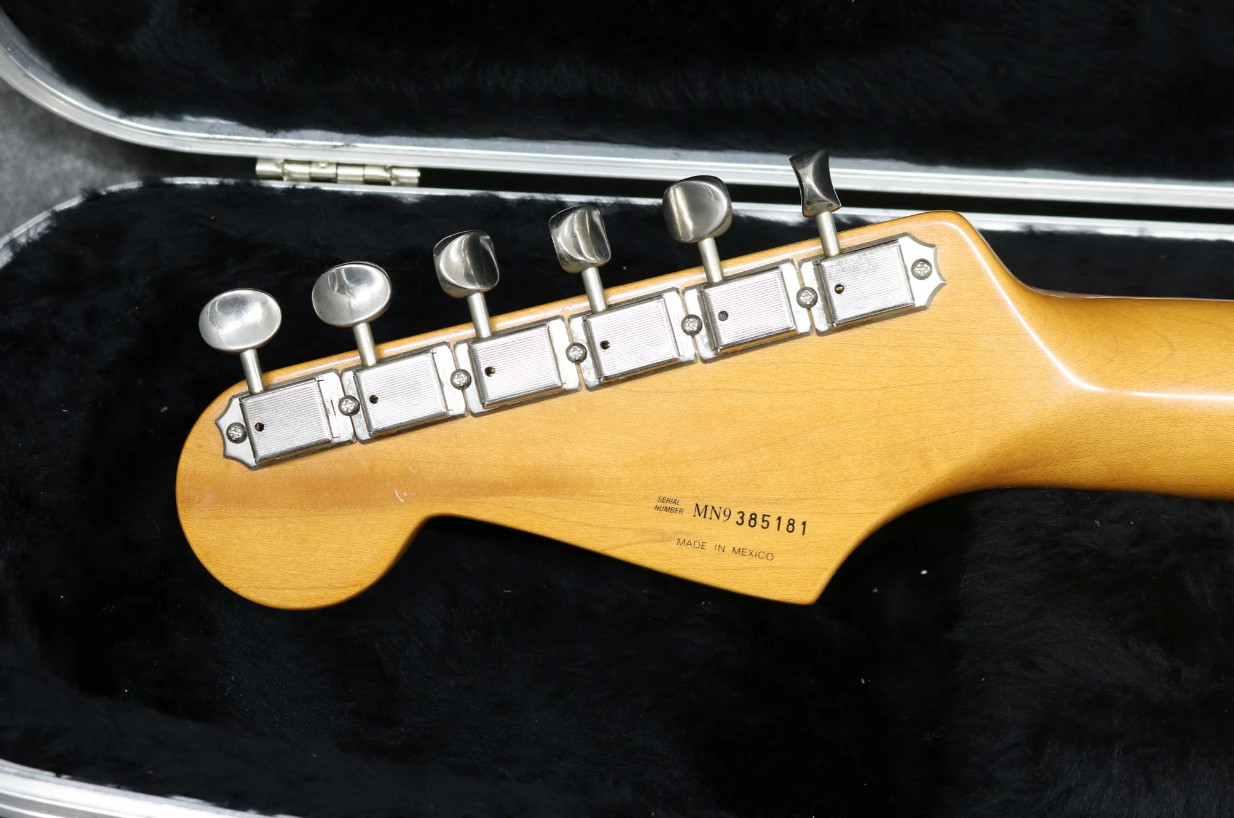 Image of a 1999 Mexican Fender Stratocaster, specifically the Hank Marvin model, highlighting the 'Made in Mexico' marking.
Image of a 1999 Mexican Fender Stratocaster, specifically the Hank Marvin model, highlighting the 'Made in Mexico' marking.
Pictured Above: A 1999 Mexican Fender Stratocaster, the Hank Marvin signature model, clearly showing the “Made in Mexico” designation.
Step 3: Verify and Seek Expert Advice
While serial numbers are a valuable tool, they are not foolproof. Fender’s serial numbering system has had overlaps and inconsistencies throughout its history. Always verify the information you glean from the serial number with other features of the guitar.
Key features to cross-reference include:
- Body Shape and Contours: Model-specific body styles evolved over time.
- Pickups: Pickup types and configurations changed across different eras and models.
- Hardware: Bridge types, tuners, and other hardware components are era-specific.
- Neck and Body Dates: Many vintage Fender guitars have date stamps on the neck heel and in the body cavities, providing more precise dating information.
- Potentiometer Codes: Electronic components like potentiometers often have date codes.
- Pickup Dates: Sometimes, pickups themselves have date markings.
For vintage or highly valuable instruments, or if you encounter any ambiguities, consulting a vintage guitar expert is highly recommended. They can assess the guitar holistically, considering all details, including the serial number, to provide a definitive appraisal.
If you’re interested in a professional appraisal of your Fender guitar or bass, don’t hesitate to reach out. Expert appraisers can offer insights that go beyond serial numbers, such as identifying replaced or restored parts (like pots, pickups, and hardware) which can significantly impact the instrument’s value and authenticity. You can typically contact appraisal services via email.
By using this guide, you can confidently navigate the world of fender guitar serial numbers and gain a deeper understanding of your instrument’s history and heritage. Remember to combine serial number decoding with careful observation of other guitar features for the most accurate assessment.
